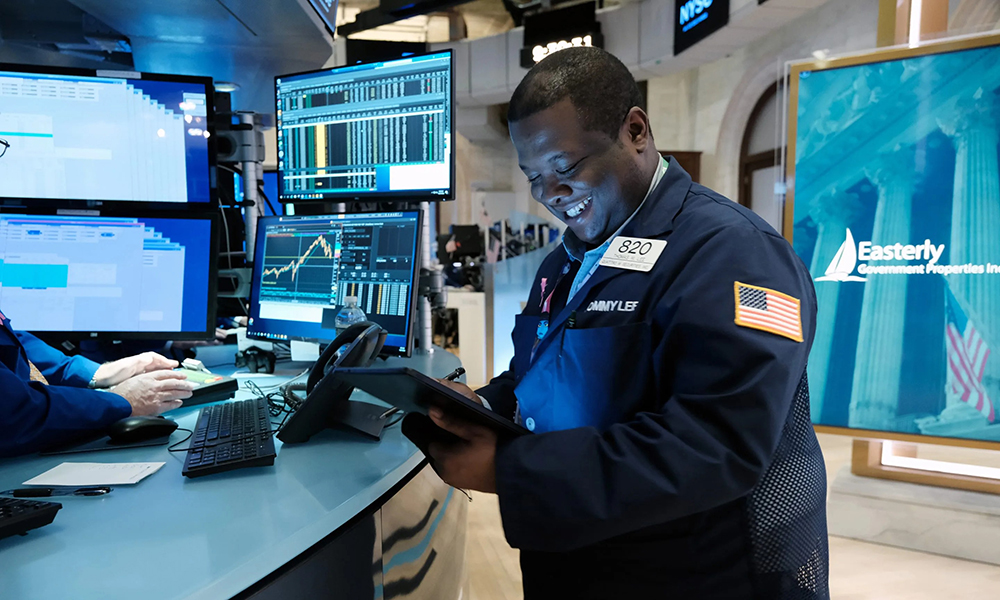
今年夏天,美国经济连续两个季度萎缩,大多数美国人都认为美国陷入了经济衰退,尽管经济学家们并没有那么确定。
但本周,虽然面临恶性通胀和华尔街对经济衰退的预测,美国经济却出现了一种新趋势。
美国经济分析局(Bureau of Economic Analysis)周四报告称,第三季度,美国国内生产总值(GDP)增长2.6%。GDP是衡量经济增长最常用的指标。
报告发布之后,美国总统拜登很快庆祝了一番。
他发推文说:“几个月来,末世论者们都说美国经济陷入衰退。但今天发布的第三季度GDP报告显示,我们有更多证据证明美国经济仍在持续复苏。”
虽然第三季度GDP确实有所反弹,但通过分析GDP增长的原因你会发现,经济前景并不容乐观。
最新GDP数据显示,出口增长了14.4%,进口减少了6.9%,使美国的贸易赤字大幅减少,GDP增长了约2.8个百分点。
联信银行(Comerica Bank)首席经济学家比尔·亚当斯认为,出口增长是因为供应链情况好转,而且美国向面临能源危机的欧洲大陆出口的石油、石油产品和天然气创下历史记录。而进口减少的原因是美国人增加了服务消费,减少了商品消费,而且由于库存积压和对通胀的担忧,美国零售商减少了支出。
Raymond James公司首席经济学家欧金尼奥·阿莱曼对《财富》杂志表示:“美国经济持续疲软,但整体GDP数据依旧隐瞒了这些问题。美联储应该慎重看待这份报告,并关注美国经济增长的基本趋势,真实情况显示美国经济日益疲软。”
阿莱曼指出,在今年第一和第二季度,贸易赤字扩大导致GDP增长放缓,这与第三季度有明显的区别。
亚当斯对《财富》杂志表示:“虽然GDP表现略好于预期,但基本经济活动的趋势依旧是在放缓。在近期内,经济可能进一步降温。”
更重要的统计数据
虽然第三季度的整体GDP数据展现了美国经济的韧性,但有经济学家提到了其他关键统计数据,认为通过这些统计数据能更好地了解美国的基本经济实力。
对国内消费者的实际最终销售是一个用于评估需求的指标,不考虑贸易赤字的影响。第三季度,该指标仅上涨了0.1%。这低于第二季度的0.5%和第一季度的2.1%。
随着高利率继续影响房地产市场,住宅投资或私人住宅与设备购买下降了26.4%。
最后,第三季度个人储蓄率下降到仅有3.3%。个人储蓄率代表消费者可以储蓄的可支配收入。这远低于1959年至2022年近9%的历史平均水平,甚至接近于2005年7月的历史最低水平2.2%。
美国银行(Bank of America)首席美国经济学家迈克尔·加彭在周四发布的一份研究报告中表示,他认为国内需求、住宅投资和个人储蓄下降等,都表明“美国国内经济处在增长衰退期”,即虽然维持正增长,但低于历史趋势。
从7月开始,加彭就预测美国经济将在今年陷入全面衰退,但9月,他更新了预测,认为在明年之前不会发生“轻度衰退”。他今天表示,周四的GDP报告证实了他的新理论。
加彭现在预测,下个季度GDP将继续正增长,增长率为0.5%,但他认为到明年年底,GDP增长会下降到负0.8%。
摩根士丹利(Morgan Stanley)首席美国经济学家艾伦·曾特纳在周四发布的一份研究报告称,第三季度“是季度增长的最高点,因为持续紧缩的货币政策的累积影响会导致经济增长低于潜力水平。”
通胀方面的好消息
虽然最新GDP报告并不像表面上看起来那么强劲,但有一个积极的基本趋势非常关键。
美联储经常用来衡量通货膨胀的个人消费支出(PCE)物价指数,本季度仅上涨了4.2%,上一季度的涨幅高达7.3%。即使不包含波动性更大的食品和能源价格,与上一季度的4.7%相比,本季度PCE物价指数也只上涨了4.5%,上涨速度放缓。
基石财富(Cornerstone Wealth)首席投资官克里夫·霍琦告诉《财富》杂志:“有一个迹象表明通货膨胀最严重的时候可能已经结束。”
但尽管通胀压力趋缓,美国经济在第三季度所展现出来的韧性,不太可能促使美联储在应对通胀的战斗中停止动作,而这从长远来看,可能对经济不利。
注册投资咨、询经纪和交易公司联邦金融网络(Commonwealth Financial Network)的固定收益投资策略师山姆·米利特对《财富》杂志表示:“尽管本季度通胀压力有所缓解,但这份报告可能成为美联储在11月的会议上再加息75个基点的理由。美国经济在第三季度展现出的韧性非常强大,尽管美联储继续收紧货币政策会抑制经济活动。”(财富中文网)
翻译:刘进龙
审校:汪皓
今年夏天,美国经济连续两个季度萎缩,大多数美国人都认为美国陷入了经济衰退,尽管经济学家们并没有那么确定。
但本周,虽然面临恶性通胀和华尔街对经济衰退的预测,美国经济却出现了一种新趋势。
美国经济分析局(Bureau of Economic Analysis)周四报告称,第三季度,美国国内生产总值(GDP)增长2.6%。GDP是衡量经济增长最常用的指标。
报告发布之后,美国总统拜登很快庆祝了一番。
他发推文说:“几个月来,末世论者们都说美国经济陷入衰退。但今天发布的第三季度GDP报告显示,我们有更多证据证明美国经济仍在持续复苏。”
虽然第三季度GDP确实有所反弹,但通过分析GDP增长的原因你会发现,经济前景并不容乐观。
最新GDP数据显示,出口增长了14.4%,进口减少了6.9%,使美国的贸易赤字大幅减少,GDP增长了约2.8个百分点。
联信银行(Comerica Bank)首席经济学家比尔·亚当斯认为,出口增长是因为供应链情况好转,而且美国向面临能源危机的欧洲大陆出口的石油、石油产品和天然气创下历史记录。而进口减少的原因是美国人增加了服务消费,减少了商品消费,而且由于库存积压和对通胀的担忧,美国零售商减少了支出。
Raymond James公司首席经济学家欧金尼奥·阿莱曼对《财富》杂志表示:“美国经济持续疲软,但整体GDP数据依旧隐瞒了这些问题。美联储应该慎重看待这份报告,并关注美国经济增长的基本趋势,真实情况显示美国经济日益疲软。”
阿莱曼指出,在今年第一和第二季度,贸易赤字扩大导致GDP增长放缓,这与第三季度有明显的区别。
亚当斯对《财富》杂志表示:“虽然GDP表现略好于预期,但基本经济活动的趋势依旧是在放缓。在近期内,经济可能进一步降温。”
更重要的统计数据
虽然第三季度的整体GDP数据展现了美国经济的韧性,但有经济学家提到了其他关键统计数据,认为通过这些统计数据能更好地了解美国的基本经济实力。
对国内消费者的实际最终销售是一个用于评估需求的指标,不考虑贸易赤字的影响。第三季度,该指标仅上涨了0.1%。这低于第二季度的0.5%和第一季度的2.1%。
随着高利率继续影响房地产市场,住宅投资或私人住宅与设备购买下降了26.4%。
最后,第三季度个人储蓄率下降到仅有3.3%。个人储蓄率代表消费者可以储蓄的可支配收入。这远低于1959年至2022年近9%的历史平均水平,甚至接近于2005年7月的历史最低水平2.2%。
美国银行(Bank of America)首席美国经济学家迈克尔·加彭在周四发布的一份研究报告中表示,他认为国内需求、住宅投资和个人储蓄下降等,都表明“美国国内经济处在增长衰退期”,即虽然维持正增长,但低于历史趋势。
从7月开始,加彭就预测美国经济将在今年陷入全面衰退,但9月,他更新了预测,认为在明年之前不会发生“轻度衰退”。他今天表示,周四的GDP报告证实了他的新理论。
加彭现在预测,下个季度GDP将继续正增长,增长率为0.5%,但他认为到明年年底,GDP增长会下降到负0.8%。
摩根士丹利(Morgan Stanley)首席美国经济学家艾伦·曾特纳在周四发布的一份研究报告称,第三季度“是季度增长的最高点,因为持续紧缩的货币政策的累积影响会导致经济增长低于潜力水平。”
通胀方面的好消息
虽然最新GDP报告并不像表面上看起来那么强劲,但有一个积极的基本趋势非常关键。
美联储经常用来衡量通货膨胀的个人消费支出(PCE)物价指数,本季度仅上涨了4.2%,上一季度的涨幅高达7.3%。即使不包含波动性更大的食品和能源价格,与上一季度的4.7%相比,本季度PCE物价指数也只上涨了4.5%,上涨速度放缓。
基石财富(Cornerstone Wealth)首席投资官克里夫·霍琦告诉《财富》杂志:“有一个迹象表明通货膨胀最严重的时候可能已经结束。”
但尽管通胀压力趋缓,美国经济在第三季度所展现出来的韧性,不太可能促使美联储在应对通胀的战斗中停止动作,而这从长远来看,可能对经济不利。
注册投资咨、询经纪和交易公司联邦金融网络(Commonwealth Financial Network)的固定收益投资策略师山姆·米利特对《财富》杂志表示:“尽管本季度通胀压力有所缓解,但这份报告可能成为美联储在11月的会议上再加息75个基点的理由。美国经济在第三季度展现出的韧性非常强大,尽管美联储继续收紧货币政策会抑制经济活动。”(财富中文网)
翻译:刘进龙
审校:汪皓
After the U.S. economy contracted for the second consecutive quarter this summer, most Americans believed that a recession was here—even if economists weren’t so sure.
But this week, despite persistent inflation and recession predictions from Wall Street, a new trend has emerged.
U.S. gross domestic product (GDP), the most common measure of economic growth, jumped 2.6% in the third quarter, the Bureau of Economic Analysis reported on Thursday.
President Biden was quick to take a victory lap after the report came out.
“For months, doomsayers have been arguing that the U.S. economy is in a recession,” he tweeted. “But with today’s third-quarter GDP report, we got further evidence that our economic recovery is continuing to power forward.”
But while GDP certainly recovered in the third quarter, when you break down what caused the jump, the outlook for the economy becomes far less optimistic.
The latest GDP numbers reflect a 14.4% surge in exports and a 6.9% drop in imports, which caused the U.S. trade deficit to drop dramatically, adding roughly 2.8 percentage points to GDP growth.
The increase in exports was a result of supply chains uncoiling, and the U.S. sending record volumes of oil, petroleum products, and natural gas to Europe amid the continent’s energy crisis, according to Bill Adams, Comerica Bank’s chief economist. And the decline in imports was caused by Americans spending more on services and less on goods, while U.S. retailers pulled back on spending owing to swollen inventories and recession fears.
“The U.S. economy has continued to weaken, but once again, the top-line GDP number is hiding some of this weakness,” Raymond James chief economist Eugenio Alemán told Fortune. “The Federal Reserve should look at this report with caution and remain mindful of the underlying trend for U.S. economic growth, which shows a weakening economy.”
Alemán noted that in the first and second quarters of this year, GDP growth was pulled down by an increasing trade deficit—a major difference compared with this quarter.
“While GDP was a little better than expected, the underlying trend of economic activity continues to slow,” Adams told Fortune. “The economy will likely cool further near term.”
A few more telling stats
While the headline GDP number shows the U.S. economy was resilient in the third quarter, some economists point to other key statistics that may give a better picture of underlying economic strength.
Real final sales to domestic purchasers, which is used to gauge demand without the impact of the trade deficit, only creeped forward by 0.1% in the third quarter. That’s down from 0.5% in the second quarter and 2.1% in the first.
Residential investment, or purchases of private residential structures and equipment, also sank 26.4% as higher interest rates continue to batter the housing market.
And finally, the personal savings rate, which represents how much disposable income consumers are able to save, dropped to just 3.3% in the quarter. That’s well below the nearly 9% historical average from between 1959 and 2022, and is even closing in on the record low of 2.2% seen in July of 2005.
Bank of America’s chief U.S. economist, Michael Gapen, said in a Thursday research note that he believes falling domestic demand, residential investment, and personal savings are a few of the examples that show “the domestic economy is in a growth recession”—a period of positive but below-trend growth.
Starting in July, Gapen predicted that the economy would fall into a full-fledged recession sometime this year, but in September he updated that outlook, arguing a “mild recession” won’t hit until next year. And today, he wrote that Thursday’s GDP report confirmed his new theory.
Gapen now expects GDP growth to remain positive next quarter, at 0.5%, but by the end of next year he believes it will drop to negative 0.8%.
Morgan Stanley’s chief U.S. economist, Ellen Zentner, said in her own Thursday research note that the third quarter will “mark the peak in quarterly growth, as the cumulative effect of tighter monetary policy begins to push growth below potential.”
Some good news on the inflation front
While the latest GDP report isn’t nearly as strong as it looks on the surface, there was one key positive underlying trend.
The personal consumption expenditures (PCE) price index, a measure of inflation commonly used by the Federal Reserve, increased just 4.2% this quarter, compared with 7.3% last quarter. And even excluding more volatile food and energy prices, the PCE price index slowed, rising 4.5%, compared to 4.7% last quarter.
“This is another sign pointing to the likelihood that the worst of inflation may be behind us,” Cliff Hodge, chief investment officer for Cornerstone Wealth, told Fortune.
But although inflationary pressures may be easing, the resilience in the U.S. economy seen in the third quarter will likely keep the Fed locked in its battle with inflation—and that could be bad news for the economy in the long run.
“Despite the slowdown in inflationary pressure during the quarter, the report should support the Fed’s plans for an additional 75 basis point hike at their November meeting,” Sam Millette, fixed income strategist for Commonwealth Financial Network, a registered investment adviser broker-dealer, told Fortune. “The economy showed impressive resilience during the third quarter despite Fed efforts to slow activity through tighter monetary policy.”






